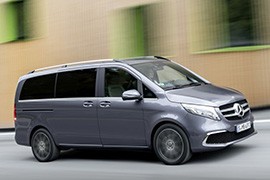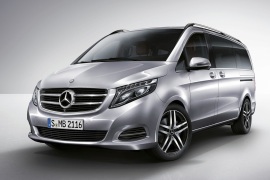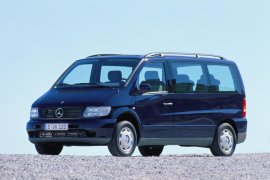MERCEDES BENZ V-Class and predecessors Models/Series Timeline, Specifications & Photos
First production year: 1996
Engines: Diesel, Gasoline
Body style: Van
In 2014, Mercedes-Benz launched its new generation of V-Class. Now the vehicle is further away from the utility vehicles from which it was based on. More luxury and more comfort were added so now it is more like a limousine with a higher stance.
For the 2020 model year, Mercedes-Benz announced important upgrades for its MPV, starting with the exterior look and continuing with the powertrains and transmission. On the grille, in the middle, the three-star logo is bigger and flanked by two silver slats. There will also be three trim levels: Avantgarde, Exclusive and AMG. The latter one has a different front grille with chrome pins, which accentuates the sporty look of the vehicle. Newly designed 18” wheels are offered, with silver and black lines in the middle of the 5-twin spoke design. The top versions may even receive 19” 10 spoke alloy-wheels with a high-sheen finish.
For the engines, Mercedes-Benz installed the new OM654 diesel unit with single or bi-turbo. While the single-turbo OM654 offers 190 hp and 440 Nm (324.5 lb-ft) of torque, while the bi-turbo has 239 hp and 500 Nm (368.8 lb-ft) of torque.
The interior received seats at the same level as the flagship S-Class, with full reclining, massage and ventilation systems, which will make any trip a relaxing experience.
After failing to sell the R-Class, the German car-maker decided to develop a better version for the V-Class range and brought an MPV that could be used as a luxury vehicle and a family car as well.
Mercedes-Benz is known for two distinct vehicle directions: personal cars and light utility vehicles. They were among the best in both areas. Maybe not all of their products were best-in-class, but for sure most of them were highly appreciated by the market. The V-Class combined the two areas.
The Vito-based vehicle featured an exquisite look for the outside, with LED daytime running lights inside the headlights, a restyled grille design, and light-alloy wheels. The descending roof-line and the sliding doors were part of the car's appeal. It was not only a family mover but also a VIP-shuttle. It was offered in three length versions with two wheelbase sizes.
Inside, the V-Class was offered in various seating configurations. If none of them could please a customer, some other coachbuilders could re-decorate the interior. The only fixed item was the driver's seat and the dashboard. The middle pivoting captain seats could form a meeting room with those who sat on the rear seats. A retractable table was on the options list.
The V-Class was available with either a 2.1-liter inline-four or a 3.0-liter V6 turbocharged diesel engines. The four-pot unit was offered in three power outputs. The car was fitted with a choice of 6-speed manual or a 7-speed automatic gearbox.
Inspired by the growing market of shuttle-vans available at other car-makers, Mercedes-Benz made its move in 1996 and launched the V-Class.
Volkswagen Transporter was one of the key players in the MPV market since the introduction of the first generation. Over time, it evolved into a range of vehicles from utility panel-vans to VIP-shuttle vehicles. Mercedes-Benz, on the other hand, it had the MB100, but it was too small.
In 1996, at the Geneva Motor Show, Mercedes-Benz uncovered the Viano. It was part of its new, V-Class, which was formed by Vito and Viano models. Both were based on a utility vehicle transformed from panel-vans into passenger vehicles. The square-look of the bodywork was a tribute to the utilitarian purpose of the car. The front side was raked and the designers tried to give it a car-like front end, with the grille and the headlights inspired by the E-Class sedan (W124).
Inside, depending on configuration, it was available with up to 9 seats, three on each row. As a luxury-VIP shuttle, it was available with captain seats in front and middle rows. The front-engine front-wheel-drive allowed a roomier interior, with the lowered floor when compared with a regular chassis-based vehicle. Options such as stationary heating system, climate control, or various audio systems including a video-player were available as a custom order.
The car was offered with either diesel or gasoline engines and the most powerful version was a Volkswagen 2.8-lite VR6 unit.


